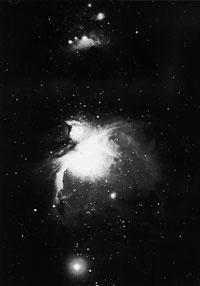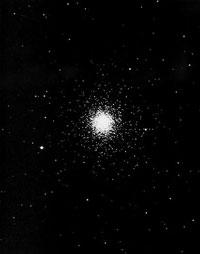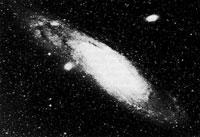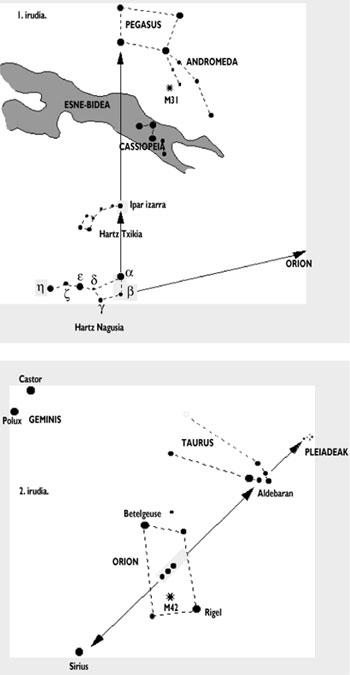Tracking the winter sky

15 billion years ago, when there was no space or time, the Big Bang occurred. The space resulting from this explosion of all parts and at the same time began to fill with matter and energy. With space time appeared and from there it is what touches us. The matter generated after this great explosion began to be stored in large units forming Galaxies. Galaxies are the bricks that form the Universe.
In these galaxies, clouds of dust and gas, called nebulae, have created stars due to the collapse of gravity. According to the characteristics of these nebulae, simple stars, multiple stars, open clusters or globular clusters appear. Stars are classified according to their color (related to temperature) and their size: we talk about white and red giants, white dwarfs, etc. All these stars, with the help of binoculars, can be seen in the sky.
But when Man first looked at the night sky, he saw a series of bright stars that, besides the Moon (besides the Great Goddess), were mixed. With the intention of overcoming the disorder he saw, the star joined the images and gave him names of animals or mythological characters. These stellar associations are called constellations.

We, this constellation world full of beautiful legends and stories, can use it to walk in the night sky. We can also find the most interesting elements that make up the universe.
Take the notorious constellation of seven stars called OSA MAYOR (URSA MAYOR) (Figure 1). While the Egyptians saw the god Hippo there, the Greeks called him Arcones. Then, for phonetic and poetic reasons, that name became Bear. The Greeks also saw a chariot in this constellation: MAIN CART. The Basques, for their part, saw the guards (Guardak), the hen with their chites (Kolkatxitos) or the thief of oxen (Itohoina), among others.
This constellation, which is undoubtedly the best known of the year, has special characteristics:
- The stars of the same constellation are named with Greek letters (<unk>, <,{, ?,>, etc.) It depends on its magnitude, that is, its apparent brightness (the one seen from Earth is related to the characteristics of the star and its distance). The highest magnitude is a, the next <, etc. However, being the stars of the BEAR MAJOR of similar magnitudes, they have been named according to their position of maintenance, without attending to real measures.
- On the other hand, the union of the stars of a constellation is totally arbitrary and have no relation between them: some stars are closer to the stars of another constellation than to their constellations. We see them because they are in the direction of our line of eye, but they are much more “behind.” However, five of the seven stars of the Great Bear (except for <unk> y |) travel simultaneously through space with twelve other stars (present in other constellations) forming a small open cluster.

The Euskonews star of this constellation (penultimate tail) is a double star visible to the naked eye: It consists of the stars Mizar and Alcor.
We will use the BIG BEAR as a key for Ortzi.
If we extend the line between the <unk> and the b of the Great Bear in the direction of Pegasus, approximately the length of the constellation, we find a star. It is not very spectacular, but it is known: North Star (Polaris). It is important to orient yourself both on land and at sea. It is the tail of a Bear or Chariot shaped constellation of smaller size and lower brightness: Thank you. The North star is a yellow supergiant, 1600 times brighter than the Sun, located 350 light-years away.
To the right of the Ortzi (extending much the line going from and to bs of the BEAR MAJOR) we will see three bright stars aligned in the center of a large square. They are the Three Kings or Marys of the constellation ORION (see figure 2). In the picture above left is Betelgeuse, an old and cold red supergiant.
It is one of the largest stars known. On the diagonal of the picture, on the other end, is the supergiant Rigel white and blue. This is much hotter. Under the center of the Three Kings, in the center of the path located at the bottom of the picture, is the great Nebula M42 of Orion. It can be seen with binoculars. It consists of gases, powders and interstellar molecules. The younger generation of this birthplace of stars is only 100,000 years old. Its reddish color can be seen in the photos.
Stretching the line of the Three Kings we reach the Sirius star of the constellation CANIS MAYOR (Izarrora). It is relatively close (8.7 light-years) and is the brightest star in the sky. Sirius has a friendly star, a white dwarf. It can only be seen by telescope.

Extending the same line in the opposite direction, we reached the Aldebarán of the constellation TAURUS (Looking at the Bull). This is an orange supergiant (you see the yellowish).
Following a little more the same line, we will reach the most known open cluster: To PLEIADEAK. It is a small group of stars (despite having a hundred stars, you can see 6, 7 or more stars depending on the vision itself or the instrument used).
It is in your hands, more readers, detect more stars and place them in the firmament, for this use a planetarium. For example, Castor and Pollux of the constellation GEMINIS, Capella de AURIGA or Procion de CANIS MINOR.
Let's go to find the largest and most fascinating thing that is below in the firmament and that you can see at a glance: Andromeda Galaxy (M31).
Stretching the < -<unk> line of the BEAR MAJOR, crossing the North Star and passing laterally through the CASSIOPEIA of the Milky Way (in the form of M or W), we will reach the large square called PEGASO. The vertex of this square closest to CASSIOPEA is that of the constellation of ANDROMEDA. From this star, a third of the road to CASSIOPEIA (see Figure 1), you can see a small and diffuse star (you can even reach prolonging the line < -> of the ANDROMEDA). We will see the light emitted 2,200,000 years ago by about one hundred billion stars. The Andromeda galaxy is equivalent and “friend” to the Milky Way, our galaxy. Both, along with others, form the Local Group of Galaxies. It is a tiny part of the universe.






